#yucca moth
Text
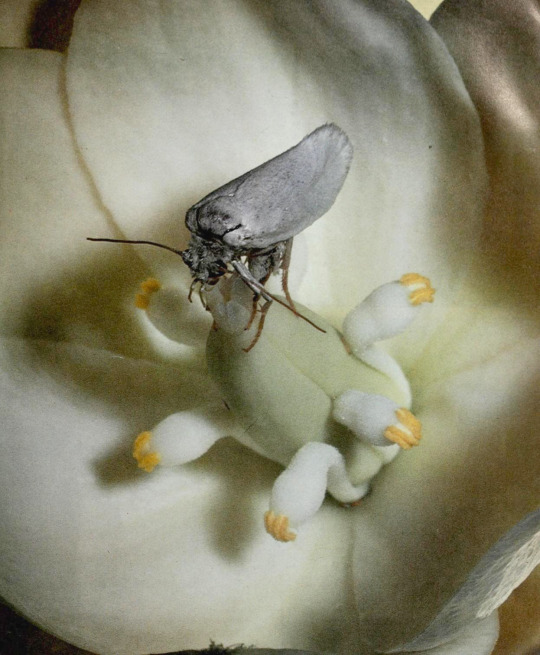
Yucca moth
By: Michael Fogden
From: Wild, Wild World of Animals: Insects & Spiders
1977
155 notes
·
View notes
Text

friends
#art#doodles#animals#bugs#harvestman#earwigs#bee flies#mealybugs#symphylan#yucca moth#giant shield bug#cicadas#<- left to right by row#using plurals to match with my other tags#insects#arachnids#flies#moths#dermaptera#diptera#hemiptera#lepidoptera#nature#I'm bad at tags lol
1 note
·
View note
Text










Yucca Moth - Tegeticula sp.
I present to you all a new delightful new specie for the blog, and a rare specimen at that. We'll need to make a small detour back to the order Coleoptera for a bit of storytime since there is another insect that favors the plant alongside this fluffy Moth (even though I said Coleoptera had been examined enough for now). With summer getting warmer and rain nourishing the plants of the neighborhood, yucca plants create their long stalks and unveil their flowers with hopes of pollination. The ones in our yard have yet to open, but when they do, I'm expecting the Brown Yucca Beetles to return and make the most of the flowers and the nutrients they have to offer. While those little beans are common, the more interesting insect to document while watching yuccas blossom are the Yucca Moths (of the family Prodoxidae), a rare branch in the Moth. For the purposes of identification, Yucca Moths have a similar form, but are not limited to white plumage. Some have dark spots, and their hindwings can feature dark colors. Pay close attention to the colors of their legs and antennae as well. Looking beyond, these creatures are the sole effective pollinators of yucca flowers. Moreover, the plants play host to the Moth's larvae, acting as a food source.
This is a special relationship between insect and plant! Specifically, it's one of mutualism to the point where they've influenced each other's evolution and they need each other to exist. In instances of True Yucca Moths, the adult Moth pollinates the flower and ensures seed production as a result; the Caterpillars later on feed on the developing seeds (and the stem innards) of the plant. There's always enough to go around, and yet Yucca Moths are quite rare in Ontario. There are instances however, where other Yucca Moths don't pollinate the plant but still lay their eggs elsewhere on the plant (they've earned the name Bogus Yucca Moths - genus Prodoxus) to ensure their Caterpillars will have food This individual is definitely a pollinator though as can be discerned from Picture 5. Bogus Moths feed on plant using a coiled proboscis while pollinating Moths have grasping mouthparts which they use to roll pollen into puffs and carry them to other yucca flowers. It's by pure luck that I noticed this one, but I'm glad it chose me and landed on my land.
Pictures were taken on June 25, 2023 with a Google Pixel 4. The post uploaded early before the final draft was pasted in, apologies for that.
#jonny’s insect catalogue#ontario insect#moth#yucca moth#Tegeticula#lepidoptera#insect#toronto#2023#june2023#nature#entomology#invertebrates
1 note
·
View note
Text
Moth Fact: Moths are sometimes pollinators! In fact Yucca plants have their own moth that they rely on to pollinate. These moths have “tentacles” to gather pollen with; these tentacles replace the long tongue most moths/butterflies have. Yucca moths vary on the exact species on yucca plant as well. These beautiful white moths tend to be very small with wingspans never going past 33 mm.

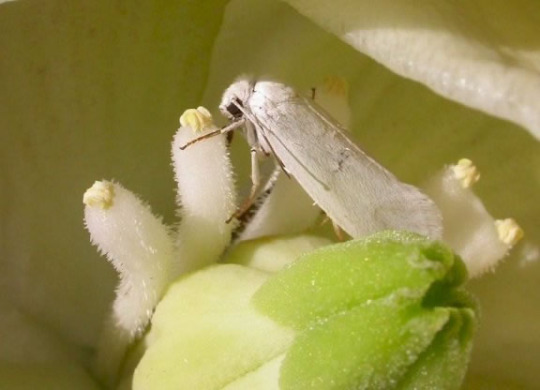
22 notes
·
View notes
Text

Day 187
A desert Pearl from her twitch hardcore world!
#daily pearl doodles#pearlescentmoon#mod morph#i took some inspo from a gerudo redesign by grooviestsadpapaya#which they said i think was kind of libya inspired?#and then just whatever i thought was most practical#also the wings are based off of yucca moths!#who have fluffy wings!!!#i love them#the colors were kind of hard to figure out#but i like them!
123 notes
·
View notes
Text
Uncharismatic Fact of the Day
In the North American southwest, one little group of insects is responsible for a large part of the Sonoran Desert’s famous vegetation. Yucca moths, members of the genus Tegeticula, are the sole pollinators of the yucca plants that thrive throughout the desert. Each species of yucca plant has a corresponding species of moth, and their relationship is mutually beneficial. After mating, female yucca moths carry pollen from one plant to another so that when her eggs hatch they have plenty of fruit and seeds to eat.

(Image: Yucca moth (Tegeticula sp.) by Kaitlin Haase)
71 notes
·
View notes
Photo

1 note
·
View note
Text

Desert Adopts Batch 2 - Creature Feature!
did another batch of adoptables, all based on animals native to the Mojave and/or Sonoran desert. they're all unique and interesting creatures, so you should take some time to look them up and learn about them :>
They're $20 each, payment thru PP only. To claim, just DM me and after money is exchanged I will send you the unwatermarked png :) youre free to do with them what you like afterwards and if you post it on toyhouse please give me the initial design credit (mobiusreach)
TARANTULA HAWK WASP: OPEN
ARIZONA BLONDE TARANTULA: OPEN
GILA MONSTER: OPEN
JERUSALEM CRICKET: OPEN
yucca moth: sold!
mojave fringe-toed lizard: sold!
#warrior cats#adoptables#design adopts#adopts#character adopt#design sale#character sale#warriors oc#warriors adopts#the jerusalem cricket is technically just the regular one common to everywhere but there IS a j cricket that is only native to-#-the kelso dunes but its really tan and not as richly colored so i went with the normal one#can you believe to learn that most animals native to the desert art tan and brown? wow
326 notes
·
View notes
Text

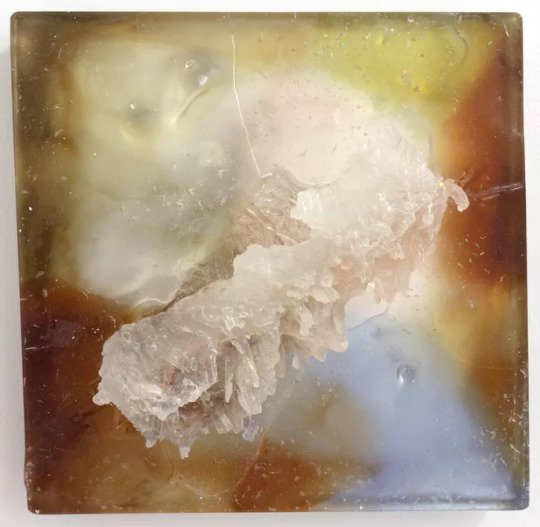
in honor of the shasta ground sloth & in honor of the yucca moth by lara saget, 2023, cast glass, fallen joshua tree branch in glass, 12 × 12 inches
49 notes
·
View notes
Text
Okay every answer HAS to mean something help me out
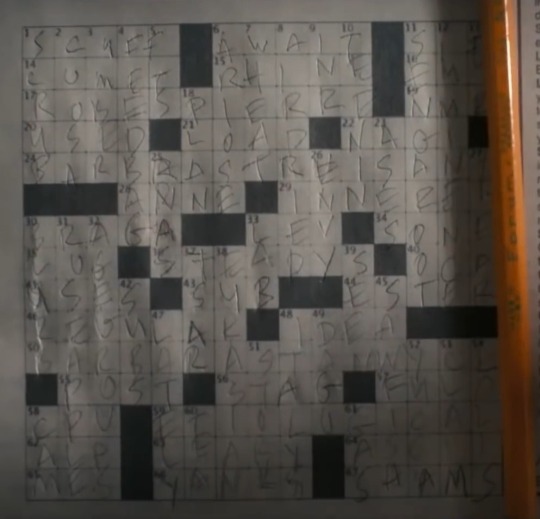
Robespierre - a French Revolutionary, known as 'the incorruptible' who was the architect of La Terreur, the mass slaughter of 17k+ enemies of the revolution via guillotine (Henry)
Lab (obvious)
Plan (obvious)
Etiological - causing/explaining something via mythical terms OR causing or contributing to the development of a disease or condition (ie how Vecna talks about humanity?)
Barbara Streisand - no idea but released the song Kiss Me in the Rain in 1979, the year this crossword was done and also her 1976 album had this track list that's very El-coded (note the opening track: SUPERMAN)

Sawfish - from the national geographic: the saws are both trackers and weapons. They're studded with small pores that allow the sawfish to sense the minute electrical fields produced by living things. Even in murky water, their prey cannot hide. Once the sawfish has found its target, it uses the 'saw' like a swordsman
Nagi - Japanese, calm/lull (before the storm?) Arabic, close friend, Polish, naked/bare (may be employed figuratively, as in naked truth)
Senga root (11 down) - milkwort (lmao) eastern North American plant having a terminal cluster of small white flowers and medicinal roots, to treat snakebite. Symbolises 'hermitage' (synonymous with 'lair', hiding/ reclusivity)
Rhine - a European river that acted as the crucial pathway into Europe for the Romans to set up strongholds in the days of their Empire and has the same origin as the English verb 'to run'
// Edit #1:
Big brained people thanking you:
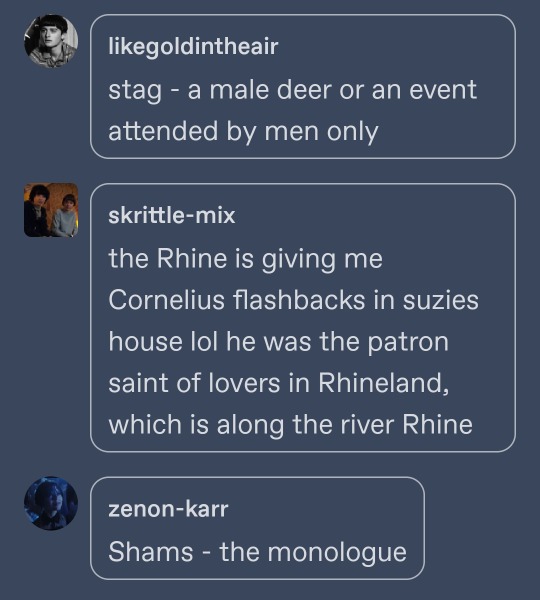
@likegoldintheair @skrittle-mix @zenon-karr
Shams could also refer to every character telling at least one plot-related lie in s4. Also means 'the sun' in Arabic.
Tsar - emperors of Russia up to 1917, and other slavic countries, derived from Caesar. Also used in the US and UK, the title "czar" is a colloquial term for certain high-level civil servants given dodgy jobs from the government to 'deal' with things (Brenner)
Edit #2: check the reblogs!
Also:
Barbara Stanwyck, an actress who has starred in movies such as California, the Night Walker, My Reputation, Forbidden, Cry Wolf and Golden Boy. Notably had a friendship with William Holden, who always wished she would get an Oscar. She received one after he died in a car accident and said:

Edit #3:
Kalis - a double-edged sword (like sawfish), also Kali (Hindu goddess of death and destruction, and El's sister)
Yucca - a plant of the agave family with swordlike leaves and spikes of white bell-shaped flowers that are dependent upon the yucca moth for fertilization, also symbolic of new opportunities, loyalty, protection and purity
Rose apple - a tropical evergreen tree cultivated for its foliage and fruit, notably has poisonous roots and stems
Ariose - characterised by melody/songlike!
ASCII - some computer shit that allows them to talk to each other (American Standard Code for Information Interchange) notably: uses seven-digit binary numbers (there's that 7 again huh)
Fula - also Cuban slang (apparently) for a shady person who cannot be trusted
137 notes
·
View notes
Text


Yucca rupicola
The various species of Yucca occur over a large part of the United States and Mexico, widely admired for their panicles of waxy white flowers. They are pollinated by specialized moths, and they generally don't make seeds here in the San Francisco Bay Area since the moths are not present here. This one is Yucca rupicola, from central Texas. It is sometimes called the twisted-leaf yucca, but though the leaves are often twisted, this is not always the case, and our plant isn't showing much inclination to do this. Its leaves are consistently greener than those of its Texan relative, Yucca pallida.
-Brian
17 notes
·
View notes
Note
Vaggie headcannons?
I love Vaggie, she’s one my favorite Hazbin characters, so I am quite excited to write these!
-Vaggie doesn’t like to wear the same things twice, so she likes to change up her outfits frequently to fit her mood
-She isn’t as much as an animal lover like her girlfriend, but she loves birds and had a parakeet as a child when she was alive
-Because she’s a moth demon, Vaggie has poor eyesight but she has excellent reflexes
-She likes savory foods, especially pupasas (corn or rice dough stuffed with fillings) and yuca con chicharron (boiled yucca root and fried pork)
-Vaggie was the oldest sibling when she was alive
-Likes feminine clothes with comfortable fabrics, and has never liked long sleeves
-Out of all the hotel residents, Vaggie sees more eye-to-eye with Husk, because both are introverts who only use their words when needed
-She has quick but neat handwriting
-Second most proficient at technology at the Hotel, other than Niffty who encouraged everyone to start using Voxtagram and their phones
I hope this headcanons did our favorite moth justice!
9 notes
·
View notes
Note
The masquerade scene book 2 or 3 (again- read them both in one go so their kind of a blur) was CRAZY INSANE. The masks. The fact that Rose's mask, while her classic blue, had belladonna leaves, and vise-versa for Belladonna. The cloaks. How Radiance wasn't wearing a mask- she doesn't need too. Everything about her is a mask. The remarked-upon lack of Opal, the shapeshifter who notoriously cannot play a different role then the person they are. The way that there were tables upon tables of untouched perfect-looking food, that were later revealed to be nothing but wax, a perfect charade that fell apart the second you tried to actually use it. The aphids and beetles and thrips and rose sawflies in the fake food as well the ones that were eating the bouquet of morning glories, yucca and snapdragons from behind, leaving the front untouched. Godddd. Insane sequence. How Radiance just drank the wine with the moth in it without flinching and then smiled. The way it was called the Lepidoptera Masquerade. And of course. The famous "but she still smelled like cinnamon" scene were they both took their masks off and allowed themselves physical contact for the first time. How the darkness was comforting outside the party and how the lights inside where "glimmering and shining, with no room for malice to hide" and how there "didn't even seem to have any room for shadows at all". God. INSANE. 10/10. Qpr Bellerose FOR. LIFE.
Yeah it was Book 3 mhm and it was ICONIC I want. to draw a rendition of Rose's masquerade outfit so badly
14 notes
·
View notes
Note
quetzalcoatl
Lovely creatures, but out of my territory, I'm afraid. I can tell you about the mothwing rattlesnake, though. Native to the Mojave Desert, lives in hollows in old yucca, and cares for its young for the six weeks it takes them to learn to fly, carrying small rodents to the nest to feed the young. They're very shy creatures, and give a loud buzzing rattle when you grt close enough for them to feel threatened, although people unfamiliar with them might mistake them for the sound if cicadas.
They have beautiful wings that come in all the colors of the desert from above and the sharp blue of the desert sky from below, to conceal them from viper hawks and the rodents they prey on, respectively. Tge young have darker scales, to better hide in the yucca nest, while the adults have pale underbellies and tan tops and sides.
Their venom is largely harmless to humans, but you should still avoid being bitten; their wings shed dust like a moth, hence the name, and most people are highly allergic to it, although in most it's just deeply unpleasant, not fatal.
4 notes
·
View notes
Note
GASP! I WANT A BUG!!! :D!!
Your bug is...
THE YUCCA MOTH!

(src)
They are the sole pollinator for the yucca plant!
They live anywhere yucca grows, with a range in the southwest US that has expanded east and north with yucca plants.
#little banjo frog#asks#answers#bug game#insect tw#rottmnt#save rise of the tmnt#save rise of the teenage mutant ninja turtles#unpause rise of the tmnt#rise mikey#mikey rise#mikey rottmnt#rise of the teenage mutant ninja turtles#save rottmnt#unpause rottmnt
31 notes
·
View notes
Text


Yucca filamentosa - Adam's thread and Needle Yucca
Subversive to most Northeast-coaster's belief there are Yucca and Cacti native to our side of the country. This Yucca has a typical range along the coastal plains of Virginia to Texas with a human influenced (pre/post colonization unstudied) northern spread up as far north as long island.
This image was taken in the New Jersey Pine Barrens, quite literally in the middle of the forest off-trail away from roads, such a curious find honestly. These plants typically enjoy harsh sandy barren environments (like the southern pinelands of the coastal plains). The fact that these plants had seeds was very interesting to me, as Yucca can only be pollinated by a specialist moth species, which means it is likely that the range of this Yucca moth is wide enough to find such an isolated population.
Regardless, this Yucca has many indigenous historic relationships, Cherokee groups have reported using the seeds and leaves to stun fish. The fruit is allegedly edible on this specific species however the seeds are poisonous so they would have to be removed. I do not recommend eating them personally unless you have a better guide than my post to direct you on that.
If you see any of these outside of the southeast or a garden, take interest in the fact that the northern limit of this species is extending further each year.
#nature#new jersey#Yucca filamentosa#spanish bayonet#pine barrens#native plant profiles#southeastern north american native plants
9 notes
·
View notes